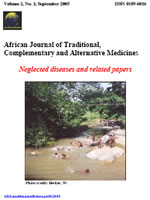
|
African Journal of Traditional, Complementary and Alternative Medicines
African Ethnomedicines Network
ISSN: 0189-6016
Vol. 8, No. 4, 2011, pp. 477-482
|
 Bioline Code: tc11063
Bioline Code: tc11063
Full paper language: English
Document type: Research Article
Document available free of charge
|
|
|
African Journal of Traditional, Complementary and Alternative Medicines, Vol. 8, No. 4, 2011, pp. 477-482
| en |
Determination of Parameters Affecting the Use of Complementary and Alternative Medicine in Cancer Patients and Detection of Prevalence of Use
Mayadagli, Alpaslan; Aksu, Atinc; Goksel, Fatih; Gocen, Erkan; Karahacioglu, Eray; Gumus, Mahmut & Pak, Yücel
Abstract
This study was conducted to find out the frequency of complementary and alternative medicine (CAM) use that could
lead to troubles in patient health and in applied standard therapy protocols when used improperly, which method is used, the
reasons for use and from which resources the information about this topic were obtained. A questionnaire consisting of 28
questions was applied to 195 patients with cancer diagnosis by a face-to-face interview. The obtained data were assessed with
SPSS 11.5 program. Out of 195 cancer patients, 100 (51.3%) were using CAM and 48.7% (n=95) were not. The most commonly
used agent was nettle (72%). This was followed by herbal teas (21%), grape molasses (20%) and black seed (20%). The frequency
of CAM use was found higher in those under age 50, in literate people, in those working during the diagnosis stage and having
disease at the later stage. While CAM was commonly recommended by friends and relatives of the patients (73%), this ratio was
only 5% for health professionals. While 51.3% of all patients were gathering information about CAM, 75% of those actually
using CAM gathered information about it. Whilst information was gathered mostly from the relatives of patients and tamperers
(47%), it can be gathered from physicians only with a ratio of 10%. Cancer patients use CAM and they gather information mainly
from unreliable sources rather than physicians. Although the primary information source should be physicians, the ratio for this
was very low (10%). We suggest that physicians should spend more time in gathering correct information and sharing them with
their patients for a better guidance.
Keywords
Complementary medicine; alternative medicine; complementary therapies; cancer
|
| |
© African Journal of Traditional, Complementary and Alternative Medicines
Alternative site location: http://journals.sfu.ca/africanem/index.php/ajtcam
|
|
